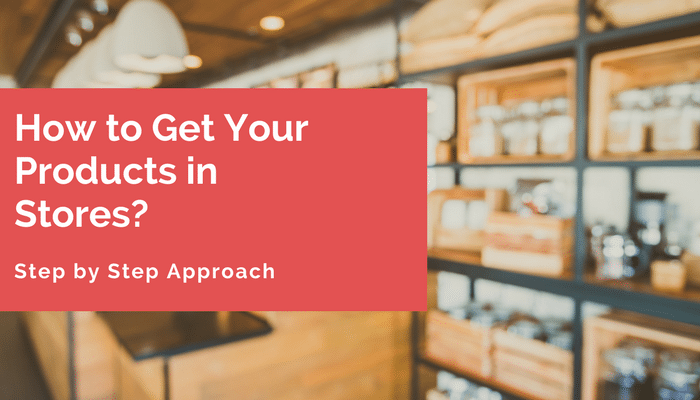How to Get Your Products in Stores?

The first challenge for any entrepreneur or wholesaler is to create a great product which follows a dream to occupy a winning shelf in a particular retail store. So here is where the business person faces the question: “How to get your products in stores?“
Retailers are not very anxious to change the status quo. New entrepreneurs mean new workload as well as high risk. So it becomes extremely challenging for any entrepreneur to get their products into independent retail stores.
The reason is that for introducing new products in their shops, retailers have a limited budget and equally limited space. So it is very daunting for entrepreneurs to meet the dream of getting your products in a store.
So I’m going to share some tips to pave your way into getting your products into your dream retail store.
Once I cover the 7 basic steps to get your product in front of retailers, I’m going to drill further into local stores and supermarkets.
7 Steps To Get Your Product In Front of Retailers
1. Start from Small and Dream Big
“Start from small and dream big” by Robert T. Kiyosaki is what you need to follow at first. Your big dream is to own a shelf at Target or Walmart. For that, you need to start from small.
Big retailers want to buy from distributors because it is an easy administration for them. Retailers always want to keep trustworthy products in their shops. So when they add a new product they want to see a record of accomplishments behind them.
So start from local and small retailers, like the shops from where you buy products often, rather than going after Target or Walmart. A positive record will help you in building rapport with big retailers in the future.
2. Research Your Target Market
A thorough research on various topics will help you a lot!
- First, know the small or local stores that you are planning to target in the beginning. It would be very good if you go to a shop from where you buy products often as the store owner will be a good acquaintance. Ask the owner various questions to get a better understanding about buying cycles, regional and nationwide buyer information, customer preferences, etc.
- The next step will be to take a note of the design of the store. Find an answer to questions like “What’s the store layout?”, “What are the various product categories?”, “How are the products grouped together?”
- Look for the products that would give good competition against your product. Compare your product against those on the basis of utility, packaging, quality, etc. Then think of answers to convince the retailer how your product will fit in there, how it is equally good like those products, or better than them.
- Choose the right store. When you are done with your above research, you will have a good idea which stores will be the one to start with: the store layout, location, types of buyers and their need will help in the sales of your product.
- Listen to the customer’s need: Now when you have chosen your target store to begin with, visit it again for a detailed survey. Try to spend time there to know it better. Listen to what the customers are asking for with the products similar to yours. Take buyer’s feedback. And accordingly, keep updating and changing your product. This will not only help you to create an effective product but also to get positive points for convincing the store owner to get a spot in the store.
3. Make the Pitch in Person
Retail owners get bombarded with e-mails and brochures, to which they pay minute attention. So try the old-school way, try to fix an appointment with the retail owner, talk to them over a cup of coffee or tea. This is where persuasion power comes into play when you contact an individual in person, that leaves a long-lasting impact. You can also create a detailed presentation on your product mentioning the key factors.
Need creation is a very important step. When you get to meet the retailer, think of them as your customers, you have to show the coinciding interests of you two, the impact your product will have on their sales, and why your product belongs in their store.
Do not make selling your product the main agenda of the meeting, think of it as a platform where you get to efficiently pitch your product and get appropriate feedback, and get acknowledged in the market.
4. Get the Margins Straight
The primary thing a retailer is looking for is Profit. So you’ve got to acknowledge the beneficial aspect from the retailer’s point-of-view as well. As told earlier if you have done your homework right, there should not be much of a problem when it comes to common grounds of interest.
So when you pitch your product, the main focus should be on how much they are going to make out of it. Your pricing methods should reflect their profit margins. You should be very thoughtful about the various situations they are going to face once they make a deal with you and especially when your product is high in demand.
For example, you should provide them with enough margin to cover their transportation cost, storage costs etc.
5. Leave a Sell Sheet
Most of the retailers will want some time to consider bringing your product into their stores. While they are making up their mind, get yourself some leverage by providing them sell sheets.
Sell sheets contain critical information about your product. It provides just the right amount of information to boost their attention and interest. Utilize the research that you had done on the buyer’s need to customize the sell sheet. Try to make it eye-catching and alluring.
A regular sell sheet is a colored brochure that includes following points:
- Advantages of your product over your competitors
- Complete layout of pricing, while considering their needs
- Specimen of your product
- Patent documents for protecting your idea
- Your contact information
- Illustrations and photographs of the product
6. Skillful Marketing
The whole convincing-your-retailer thing might not be that fatiguing if you are able to make an impression that customers are already going crazy for your product.
This step involves surveys, customers’ feedback, statistics about your competitors and showing how you have an edge over them. For that, you have to put a lot of marketing effort before coming to retailers, like giving free sample products to your target customers and taking their testimonials.
Reach out to your customers with the help of the giant web of social media, generate articles and blogs about your product, advertise them and grab a customer-base even before launching the product. This will make the buyers call you because the customers are asking for it. The retailers should presume that your product is going to sell itself so it will drive the odds in your favor.
7. Get Your Packaging Right
Size matters! When it comes to a brick-and-mortar retail store, one of the very important aspects retailers consider is: Does your product fit in their store? I mean literally.
So the packaging is something that you need to focus on to get the first impressions right and make the retailer comfortable with your product. You do not want to cover their store’s physical area more than your product deserves with that margin.
The key is being catchy, something customers will stop and stare at for a while. Skilled designing is required to make your product worth their space. Bring some sample products to get their mind acquainted with the idea of the product in their store shelves.
How to Get Your Product in Local Stores
Here, the key is about being hyper local? What’s that? This means going on foot or car in a radius around your warehouse or business. Ideally you want to target local retail stores within 5 kilometres or miles for a start. This should give you a decent catchment area of retailers to work from.
Next, you have a lot of sales footwork ahead. Assuming these are small and medium-sized retailers, your best bet is to arrive unannounced during the least busy part of the day. Typically, this would be when the retail store opens. And you need to prepare a travelling sales kit from the boot of your car:
- Sample products in your inventory, including variants where possible
- Sales terms covering minimum order quantity (MOQ), turnaround time, payment terms, shipping method and insurance, and exchanges and returns.
- Simple line sheet showing your company name, terms, ordering instructions, and the product catalog. In addition, your catalog needs to show the wholesale price and MSRP, SKU and product name, and sizes and variations at a minimum.
How to Get Your Product in Supermarkets
For supermarkets, the approach is similar to that of getting your foot into local stores. Except you might be dealing with a regional or national chain with professional buyers. Here, it would be best to prepare a list of potential supermarket names starting with mom ‘n pop stores. Once you have a target list, call and get the name of the buyer and arrange a meeting with him or her.
Part of your research should also include visiting the target supermarkets. Are they a good fit with your products? How do they display perishable and non-perishable products? Is the supermarket clean and well kept? How about the condition of their warehouse area?
You’ll also need to do homework and prepare a checklist of things before your first meeting, including bringing sample products, sales terms, and line sheets to the first meeting.
Finally, depending on the size of the supermarket you may not have much negotiating power. These fast consumer goods retailers after all rely on high volume to drive sales. You may need to accept their terms in order to get your products onto their shelves.
Conclusion
So it all comes down to having a good product, then only all of the above steps fall into places. Recognizing your target customers and, accordingly, the suitable stores are the foundation of a large customer base. Be realistic in your approach, master the perfect pitch and you are good to go!
I hope that the above tips will get your product into a successful retail store. In the end, I would like to quote “A positive attitude will lead to positive outcomes.” This alone will be the most important tip for you to become a successful entrepreneur.
In the initial stages of business, learn to take ‘No’ for an answer. It’s not the end of the world if one retailer does not accept your product in their stores.
Train yourself to see the good in every situation. When rejected, analyze your approach from scratch and find out what went wrong.
Go through the steps once again, make amendments if required and get your facts straight!
To sum it up, if you believe in your product and think it has potential then do not give up on small failures, fight for it and, eventually, you will see your product in leading stores’ shelves in near future.








